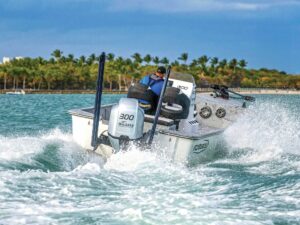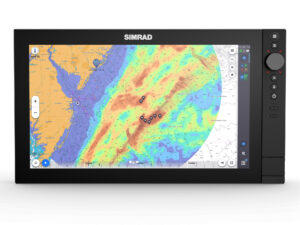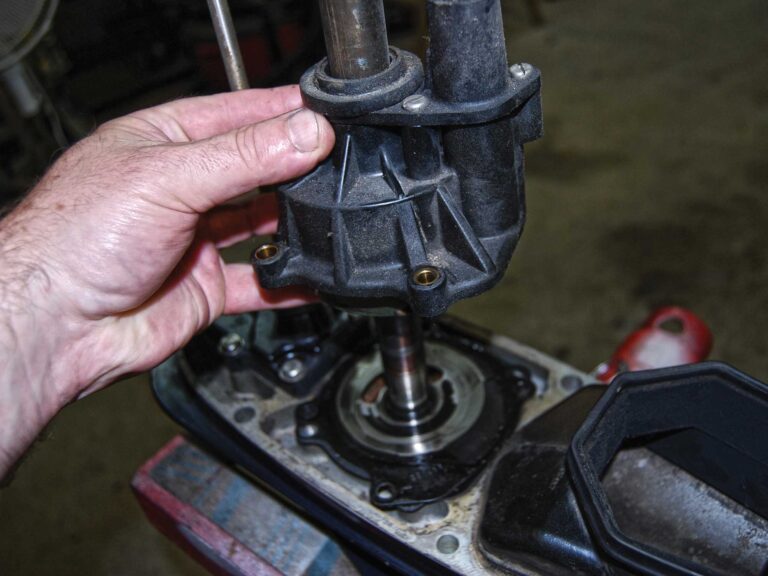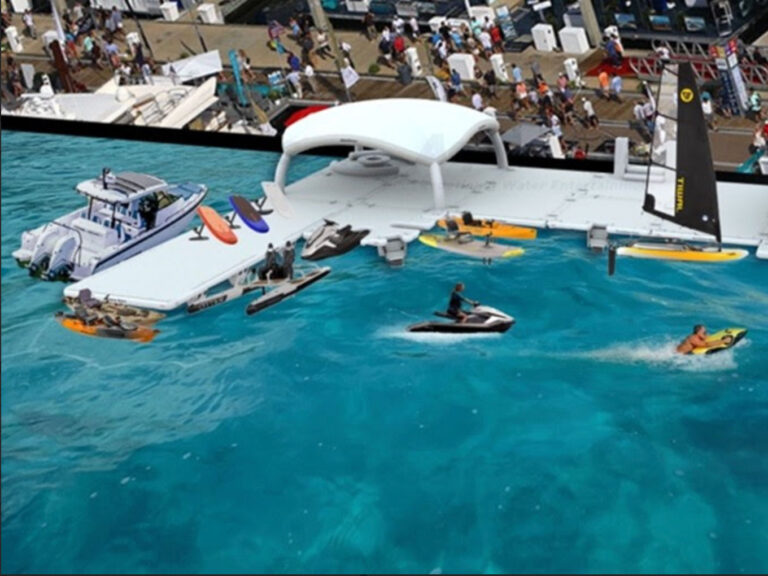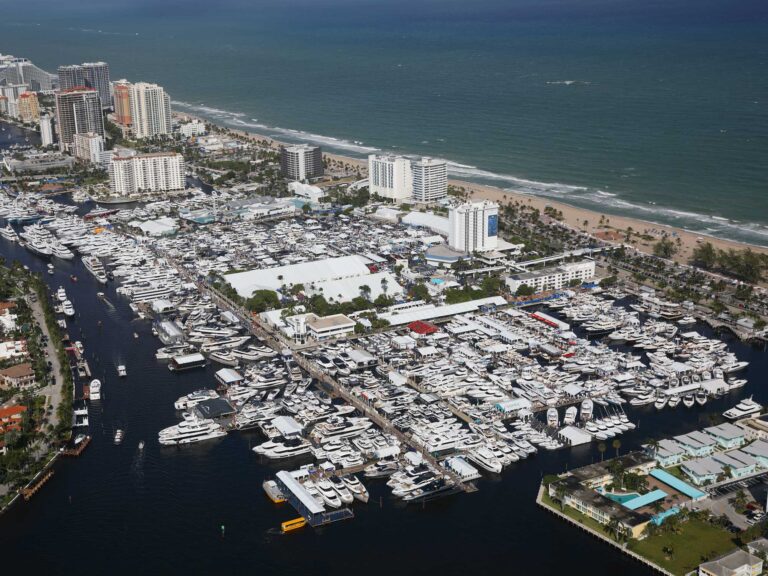Just because your boat’s designed for the water doesn’t mean it wants to stay there 24/7. Stored in the wet stuff it’s assaulted by a host of environmental factors, from marine growth to the simple battering of the waves. Above the water, it’s safely out of reach, cozy and dry until the time comes for you to splash it again.
Out-of-water storage has economic benefits as well. There’s no need for bottom paint, no service calls from a guy with a scuba tank and a scraper, and fewer concerns about corrosion and eroded zincs. Most lifts and docking systems also eliminate the need for — dare we say it? — dock lines, at least at your home port. Their drive-in or drive-on style provides an easier target for that nervous captain who wants to avoid marring the neighbor’s gelcoat, and lifts can even save a few marriages by eliminating a “No! Your other right” conflagration while docking.
Traditional cable-driven lifts are a staple from coast to coast. A new generation of lifts, however, promises to combine innovation and cost-effectiveness, while still satisfying the goal of keeping your boat both high and dry. See if one suits your boating situation.
HydroHoist UltraLift-2
boatlift.com
Wondering about that funny-looking pontoon boat that’s occupying your neighbor’s slip? It just might be a HydroHoist. A time-tested design with the drive-on appeal of a traditional lift, HydroHoist’s UltraLift-2 pumps a boat above the water by blowing air into custom-molded, high-impact polyethylene tanks that resemble, what else, pontoons.
Assembly is not a do-it-yourself proposition. A dealer will help you choose the proper lift for your application and assemble it at your slip. UltraLift-2 models can accommodate boats up to 50 feet in length and 32,000 pounds at floating docks with U-shaped slips, or vessels up to 26 feet in length and 6,600 pounds at floating docks, extrawide slips or L-shaped moorings. (Don’t fit the profile? HydroHoist’s Side-Tie “B” series is designed to lift up to 30,000 pounds at fixed or floating docks.)
When a boat is in water, getting it onto the lift is a simple matter of driving it into position atop the bunks. Electric blower motors then pump air into the seamless, impact-resistant tanks to lift both the boat and the hot-dip-galvanized frame supporting it completely out of the water. The entire process can take as little as three minutes. Tank fittings are airtight, and a 4-inch frame channel, a 3-inch adjustable expansion channel and heavy-duty quarter-inch torsion bars are used in the construction of the structural frame. Five-inch high-density polypropylene square-hole bushings, Grade 8 pivot hardware and structural grade dock brackets with molded bumper guards ensure a worry-free attachment dockside. Optional plank kits facilitate covering or hull maintenance when out of the water.
Specs
Max LOA: 50′
Max Weight: 32,000 lb.
Electric: Yes
Min. Depth: 4-7′
DIY Install: No
Key Features: High-impact polyethylene tanks, above-water steel supports
Dr. Dockwise says: Don’t lose power dockside, unless you have a generator that can handle the load. Air can be released to lower the boat into the water, but to raise it you need power. Minimum water depth also varies between four and seven feet, based on capacity.

Fab Dock
fabdock.com
Forget hoisting, boosting and skidding your boat above the waterline. The low-profile Fab Dock lets it stay right where it is, effectively pushing the water away from the hull by surrounding it from below with an inflatable PVC or polyurethane collar and polyurethane alloy floor. Think rubber raft or inflatable kiddie pool. That inflatable collar surrounds your boat and protects it from dock damage. Bilge pumps pump the Fab Dock dry when the boat is in position and work to continually keep things that way while the boat is not in use. It’s kind of like your own personal dry dock, except this one is portable and positioned right at your dock or slip. Move to a new spot and the Fab Dock rolls up and goes with you.
Assembly is minimal. Simply unroll, slide into the water and inflate. The back half of the collar is a separate, weighted chamber; when deflated, the weight causes it to sink far enough below the surface to effectively open the door for entry. Just get the bow into the opening between the port and starboard tubes, and the hull is guided into position. Once in place, that back gate is then inflated with a portable electric pump attached to the boat battery, a solar panel or shore power, completing the full wraparound collar and surrounding your boat. Water left within is emptied in about 30 to 45 minutes by submersible pumps, located within a housing on the floor. An electronic sensor turns the pumps on should water enter the Fab Dock via rain or waves.
Each Fab Dock is custom manufactured to fit the hull almost like a glove, taking into account more than 25 data points that compensate for individual running gear. In some cases, pockets may be incorporated into the durable polyurethane alloy floor; areas subject to added stress are reinforced with pure polyurethane. It’s tough stuff. According to the manufacturer, it can take a stab from a combat knife.
Specs
Max LOA: N/A
Max Weight: N/A
Electric: Yes
Min. Depth: 1′
DIY Install: Yes
Key Features: Custom-made for any size boat, PVC or polyurethane tubing and flooring, no metal or moving parts
Dr. Dockwise says: The custom design process takes about four weeks from the time of order.
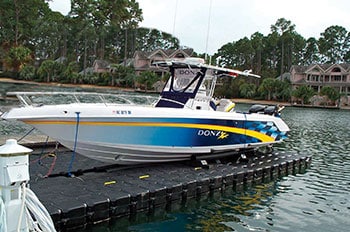
Jet Dock Universal Boat Dock/BoatLift
jetdock.com
High-density, 20-inch polyethylene cubes, each with more than 200 pounds of buoyancy, are the key to the Jet Dock’s success. Connected together, they form a drive-on platform with no moving parts. It doesn’t require power. A recessed central portion, corresponding to the shape of the hull, guides the boat into position as it is driven onto the dock. A pipelike bunk system offers stability and support, forming a cradle much like the bunks of a trailer. To launch, lower the drive, start the engine, and back off the platform under power. You’ve heard that platforms can be hard to get off? Jet Dock addresses the issue with a pivoting pedestal winch for hoisting and launching.
Jet Docks allow for both professional and consumer assembly. The dock ships in three primary pieces. A variety of mooring systems anchor the Jet Dock to a bulkhead, seawall or fixed dock; a Tide Manager system compensates for changing water height.
The traditional lift works best for outboard, sterndrive and jet-drive craft to 25 feet and 5,000 pounds. An air-assist option adds air chambers under the stern section to lift boats up to 50 feet and 40,000 pounds, or inboard craft to 25 feet and 10,000 pounds.
Specs
Max LOA: 26′
Max Weight: N/A
Electric: No
Min. Depth: N/A
DIY Install: Yes
Key Features: Pivoting pedestal winch, perimeter tie-off cleats, polyethylene blocks, nonskid surface
Dr. Dockwise says: Inboards can’t be powered off and must be launched completely before starting.
Sunstream V-Lift
sunstreamcorp.com
Sunstream’s V-Lift entered the market with impressive fanfare, taking home an NMMA Innovation Award at the 2012 Miami International Boat Show. Its four independent, polyethylene air tanks, linked together in the shape of a V, cradle the boat within. Drive on in its lowered position and trigger the quad blower via a key-fob remote, and the V-Lift raises in just two minutes. Click again to launch and you’re splashed in about 75 seconds. The beefy air tanks provide natural fendering.
Sunstream claims the V-Lift can be assembled in as little as 30 minutes. It’s not quite that simple, but most consumers should be able to accomplish the task in about an hour with just a screwdriver. Professional assembly is also available. All the necessary components — blower motors, valves, etc. — are built into the tanks themselves, eliminating the need for hoses or dockside power packs. Two 24-volt, maintenance-free DC batteries furnish blower power. An AC transformer can be plugged into a GFI-protected outlet for occasional charging; optional solar-power charging kits are also available.
Once assembled, the entire unit can be towed into place and tied into position. Its size allows it to fit in slips as narrow as 10 feet. Sunstream also offers slide mounts. There’s no load transferred to the dock, there are no leveling brackets, and the lift can operate in as little as three feet of water. A tank-monitoring system automatically fills the air tanks if water is detected. The standard lift can handle up to 7,000 pounds. Capacity can be increased to 11,000 pounds by adding more tanks.
Specs
Max LOA: N/A
Max Weight: 11,000 lb.
Electric: Yes (DC)
Min. Depth: 3′
DIY Install: Yes
Key Features: Four polyethylene air tanks, hoseless rechargeable DC air-pump system, built-in chine guides
Dr. Dockwise says: The maximum beam the V-Lift can handle is 8 feet 6 inches — or 10 feet with an optional 18-inch spacer plate at the centerline. The V-Lift also can’t be left in the water in areas where ice forms.
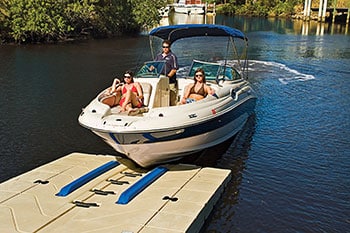
EZ Dock EZ BoatPort
ez-dock.com
Lifting is not in the cards for EZ Dock’s EZ BoatPort. Boaters simply drive on top of the BoatPort’s roto-molded, polyethylene platform. A sloped aft design and rollers adjacent to the keel ease the transition. The latter can be adjusted, or added to, to accommodate individual hull designs. Bunk runners align the hull and provide side-to-side support once in position. Normal dock lines can be affixed to cleats to provide extra security once on the platform. When it’s time to head out on the water, just lower the motor and back away. The air-filled platform features no moving parts, and nothing to corrode. This “lift” also stays at water height, guaranteeing it won’t block that million-dollar view.
By itself, the 13-foot-10-inch by 6-foot-6-inch BoatPort makes a functional dry dock, but for true ease it’s almost a must to add optional side extensions; two, on each side of the dock, add 40 inches of real estate necessary to access the sides of the boat for cleaning or loading/unloading. Modular components connect via a patented rubber coupler system. Side extensions also add buoyancy, upping the BoatPort’s 2,000-pound capacity to 3,000 pounds. An optional Air-Assist Float Tank can also be added under the lift’s aft end to increase total capacity to 5,000 pounds. The tank’s pump can be turned on and off via a variety of control units, including a standard AC-powered pump with manual control, battery power with solar charging system, or AC power with remote control pump unit.
Maintenance of the polyethylene sections is minimal. The beige color is cool to the touch, and a textured top surface prevents slips. The entire assembly can be attached to existing docks or seawalls, anchored to a shoreline abutment, post or piling, or anchored independently to the bottom via pipes.
As the EZ Dock name implies, the BoatPort can also be configured to be part of an entire modular dock system.
Specs
Max LOA: 24′
Max Weight: 5,000 lb.
Electric: No
Min. Depth: N/A
DIY Install: Yes
Key Features: Self-centering rollers, customizable skid bunks
Dr. Dockwise says: The EZ BoatPort is best geared toward skiffs, runabouts, fishing boats and jet boats to 24 feet, providing they fall within the weight limit.
5 Tips for Selecting the Right Dock/Lift System
If the idea of one of these alternative docking systems seems like a good fit for you, the next step is determining, well, which one is a good fit for you. – The Boating Tech Team
Do You Have Access To Shore Power?
Don’t buy one that requires an AC power source to work or to charge the batteries unless you have an AC power source near the dock.
Hire The Pros
Many lifts are possible to install yourself, but check with the manufacturer to see if professional installation is available. It might save you time and money in the long run.
Where Can You Store It During The Winter?
If you need to remove your dock on a seasonal basis, make sure it’s easy to remove and store on land.
Will It Attach To A Floating Or Fixed Dock?
Make sure the model you choose is appropriate for your marina, slip or mooring, and, if needed, has a gangway that can adjust for tidal changes.
Feel The Heat
Some plastic docks can retain a lot of the sun’s heat. Make sure there’s a walkable section or that your feet are properly shod.

